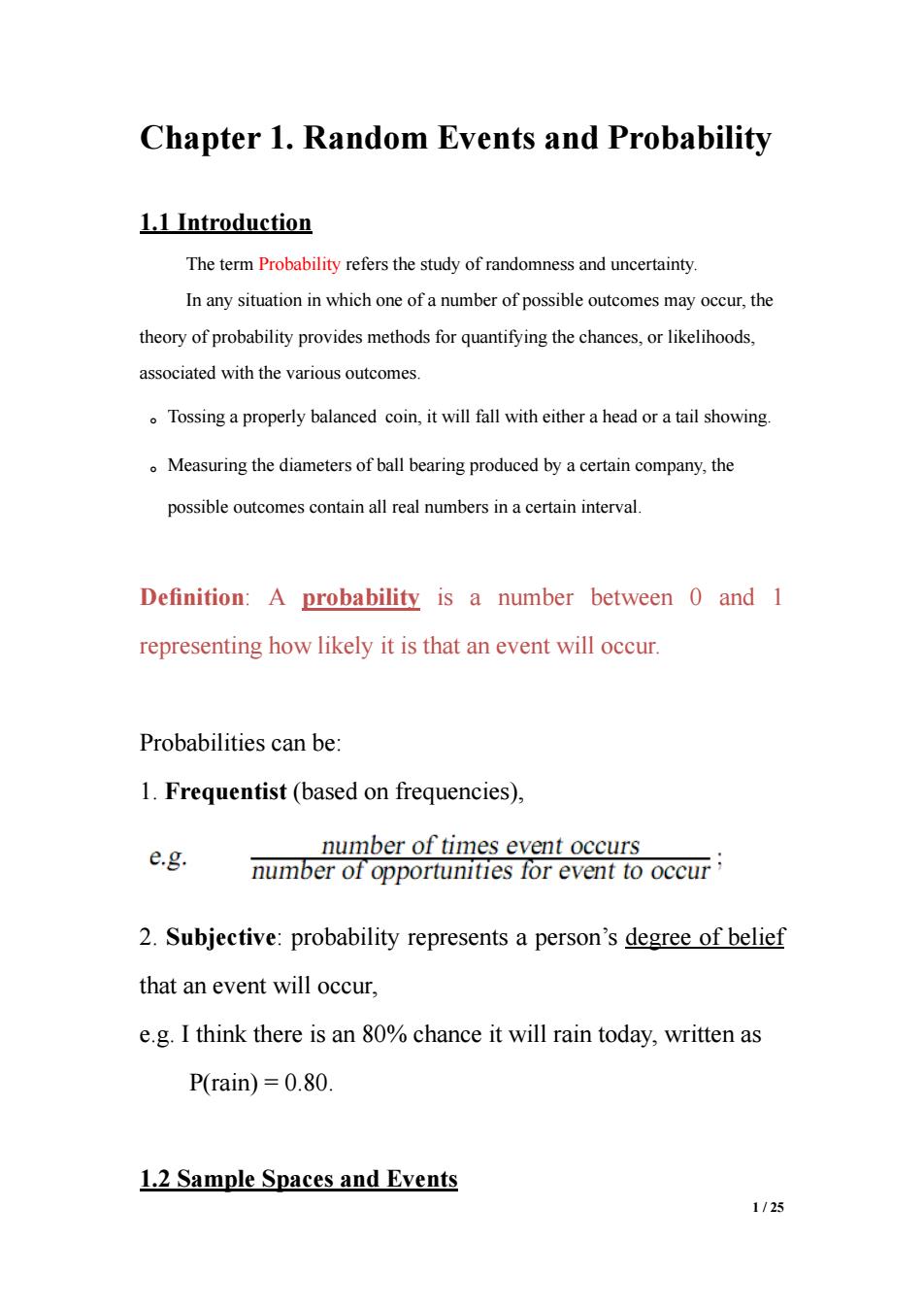
Chapter 1.Random Events and Probability 1.1 Introduction The term Probability refers the study of randomness and uncertainty. In any situation in which one of a number of possible outcomes may occur,the theory of probability provides methods for quantifying the chances,or likelihoods, associated with the various outcomes. Tossing a properly balanced coin,it will fall with either a head or a tail showing. Measuring the diameters of ball bearing produced by a certain company,the possible outcomes contain all real numbers in a certain interval Definition:A probability is a number between 0 and 1 representing how likely it is that an event will occur. Probabilities can be: 1.Frequentist(based on frequencies), number of times event occurs e.g. number of opportunities for event to occur 2.Subjeetive:probability represents a person's degree of belief that an event will occur, e.g.I think there is an 80%chance it will rain today,written as P(rain)=0.80 1.2 Sample Spaces and Events 1/25
1 / 25 Chapter 1. Random Events and Probability 1.1 Introduction The term Probability refers the study of randomness and uncertainty. In any situation in which one of a number of possible outcomes may occur, the theory of probability provides methods for quantifying the chances, or likelihoods, associated with the various outcomes. 。Tossing a properly balanced coin, it will fall with either a head or a tail showing. 。Measuring the diameters of ball bearing produced by a certain company, the possible outcomes contain all real numbers in a certain interval. Definition: A probability is a number between 0 and 1 representing how likely it is that an event will occur. Probabilities can be: 1. Frequentist (based on frequencies), 2. Subjective: probability represents a person’s degree of belief that an event will occur, e.g. I think there is an 80% chance it will rain today, written as P(rain) = 0.80. 1.2 Sample Spaces and Events
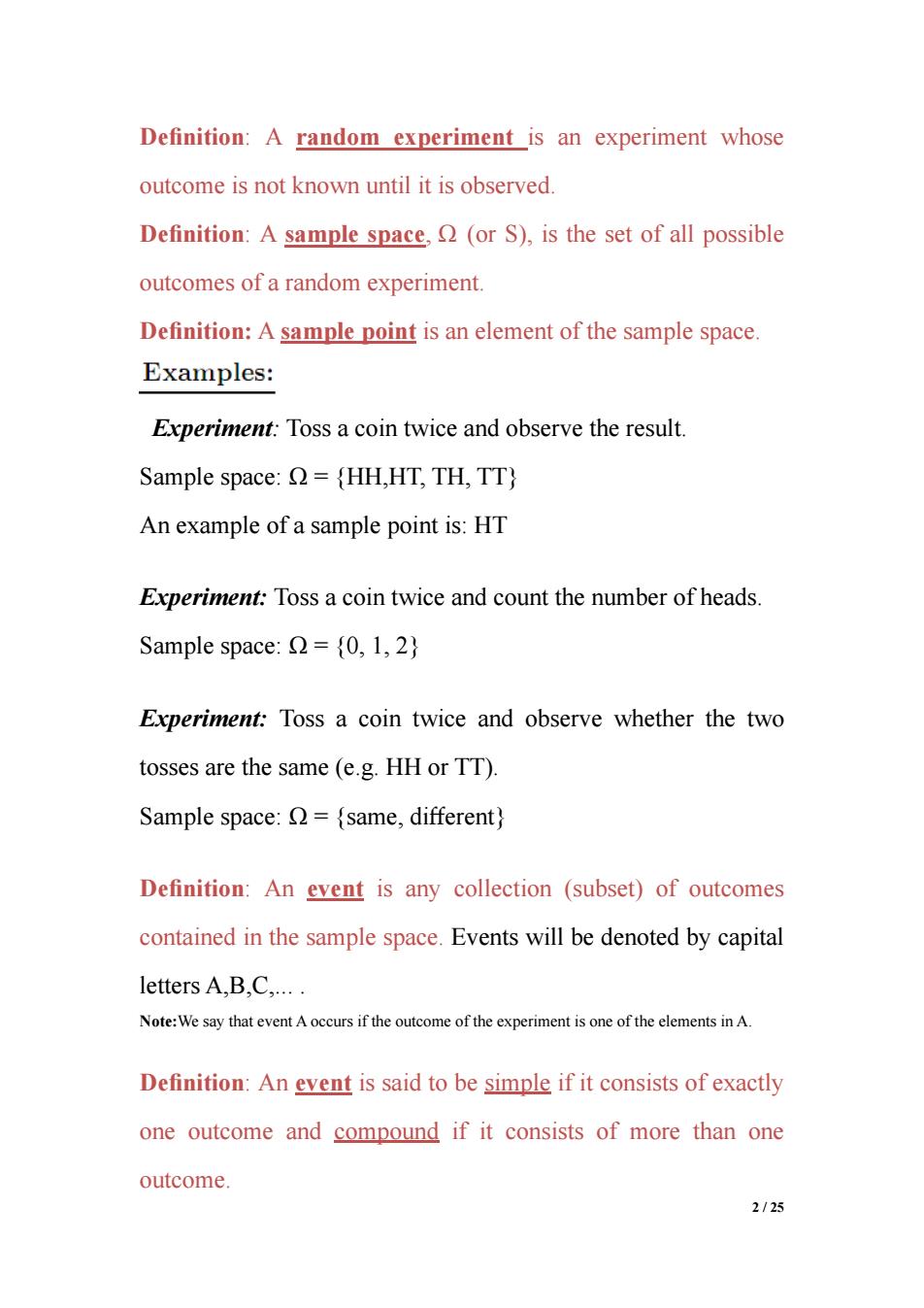
Definition:A random experiment is an experiment whose outcome is not known until it is observed. Definition:A sample space,(or S),is the set of all possible outcomes of a random experiment. Definition:A sample point is an element of the sample space. Examples: Experiment:Toss a coin twice and observe the result. Sample space:{HH,HT.TH.TT} An example of a sample point is:HT Experiment:Toss a coin twice and count the number of heads. Sample space:={0,1,2) Experiment:Toss a coin twice and observe whether the two tosses are the same(e.g.HH or TT). Sample space:={same,different) Definition:An event is any collection (subset)of outcomes contained in the sample space.Events will be denoted by capital letters A.B.C,.... Note:We say that event Aoccurs if the outcome of the experiment is one of the elements in A. Definition:An event is said to be simple if it consists of exactly one outcome and compound if it consists of more than one outcome 2125
2 / 25 Definition: A random experiment is an experiment whose outcome is not known until it is observed. Definition: A sample space, Ω (or S), is the set of all possible outcomes of a random experiment. Definition: A sample point is an element of the sample space. Experiment: Toss a coin twice and observe the result. Sample space: Ω = {HH,HT, TH, TT} An example of a sample point is: HT Experiment: Toss a coin twice and count the number of heads. Sample space: Ω = {0, 1, 2} Experiment: Toss a coin twice and observe whether the two tosses are the same (e.g. HH or TT). Sample space: Ω = {same, different} Definition: An event is any collection (subset) of outcomes contained in the sample space. Events will be denoted by capital letters A,B,C,... . Note:We say that event A occurs if the outcome of the experiment is one of the elements in A. Definition: An event is said to be simple if it consists of exactly one outcome and compound if it consists of more than one outcome
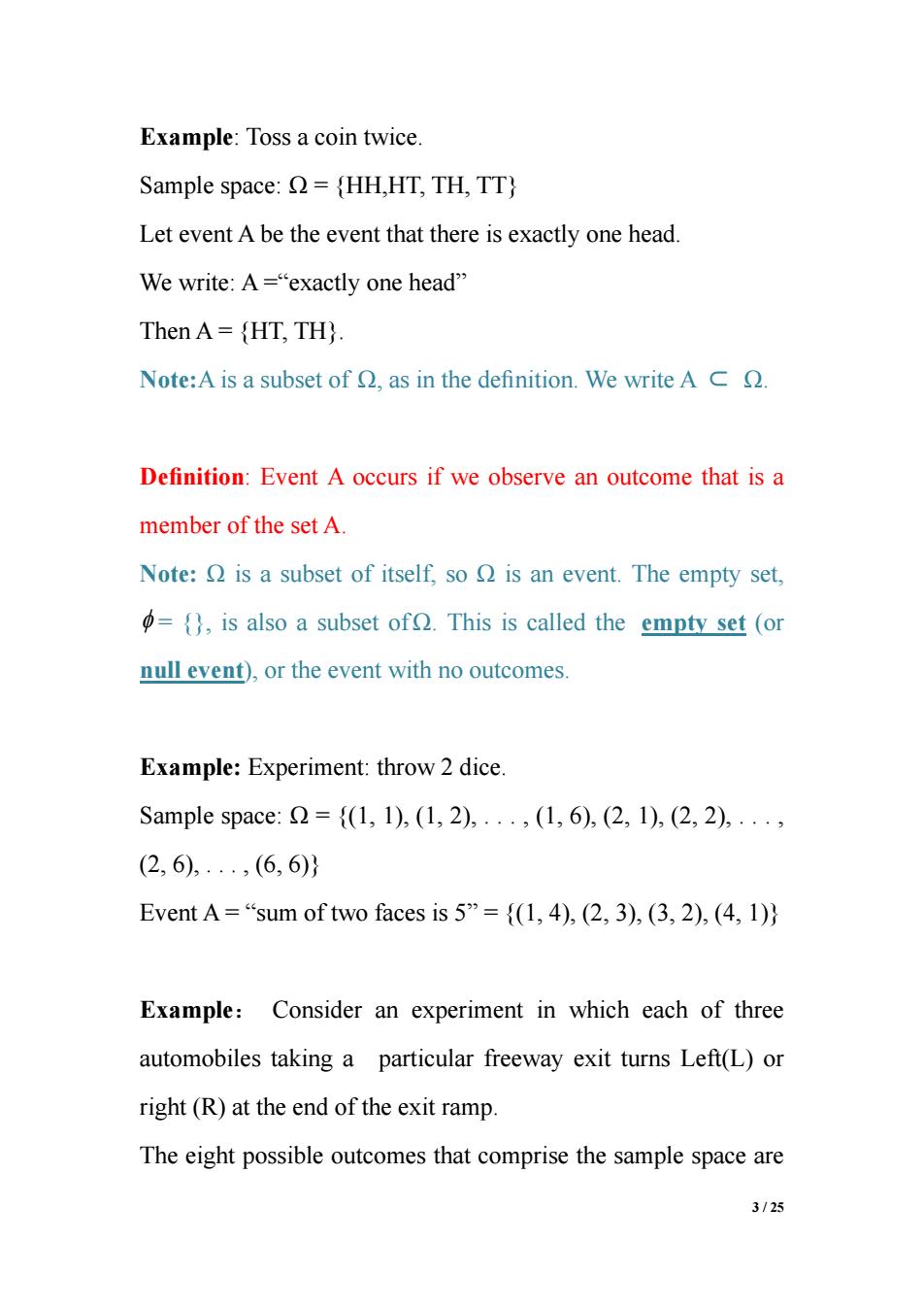
Example:Toss a coin twice Sample space:(HH,HT,TH,TT) Let event a be the event that there is exactly one head. We write:A="exactly one head" Then A=(HT,TH). Note:A is a subset of as in the definition.We write A C Definition:Event A occurs if we observe an outcome that is a member of the set A Note:Q is a subset of itself,so is an event.The empty set, =is also a subset of.This is called the empty set (or null event),or the event with no outcomes. Example:Experiment:throw 2 dice. Sample space:2={(1,1),(1,2),..,(1,6),(2,1),(2,2),.., (2,6),..,(6,6)} Event A="sum of two faces is 5"=((1,4),(2,3),(3,2),(4,1)) Example:Consider an experiment in which each of three automobiles taking a particular freeway exit turns Left(L)or right(R)at the end of the exit ramp. The eight possible outcomes that comprise the sample space are 3125
3 / 25 Example: Toss a coin twice. Sample space: Ω = {HH,HT, TH, TT} Let event A be the event that there is exactly one head. We write: A =“exactly one head” Then A = {HT, TH}. Note:A is a subset of Ω, as in the definition. We write A ⊂ Ω. Definition: Event A occurs if we observe an outcome that is a member of the set A. Note: Ω is a subset of itself, so Ω is an event. The empty set, φ = {}, is also a subset of Ω. This is called the empty set (or null event), or the event with no outcomes. Example: Experiment: throw 2 dice. Sample space: Ω = {(1, 1), (1, 2), . . . , (1, 6), (2, 1), (2, 2), . . . , (2, 6), . . . , (6, 6)} Event A = “sum of two faces is 5” = {(1, 4), (2, 3), (3, 2), (4, 1)} Example: Consider an experiment in which each of three automobiles taking a particular freeway exit turns Left(L) or right (R) at the end of the exit ramp. The eight possible outcomes that comprise the sample space are
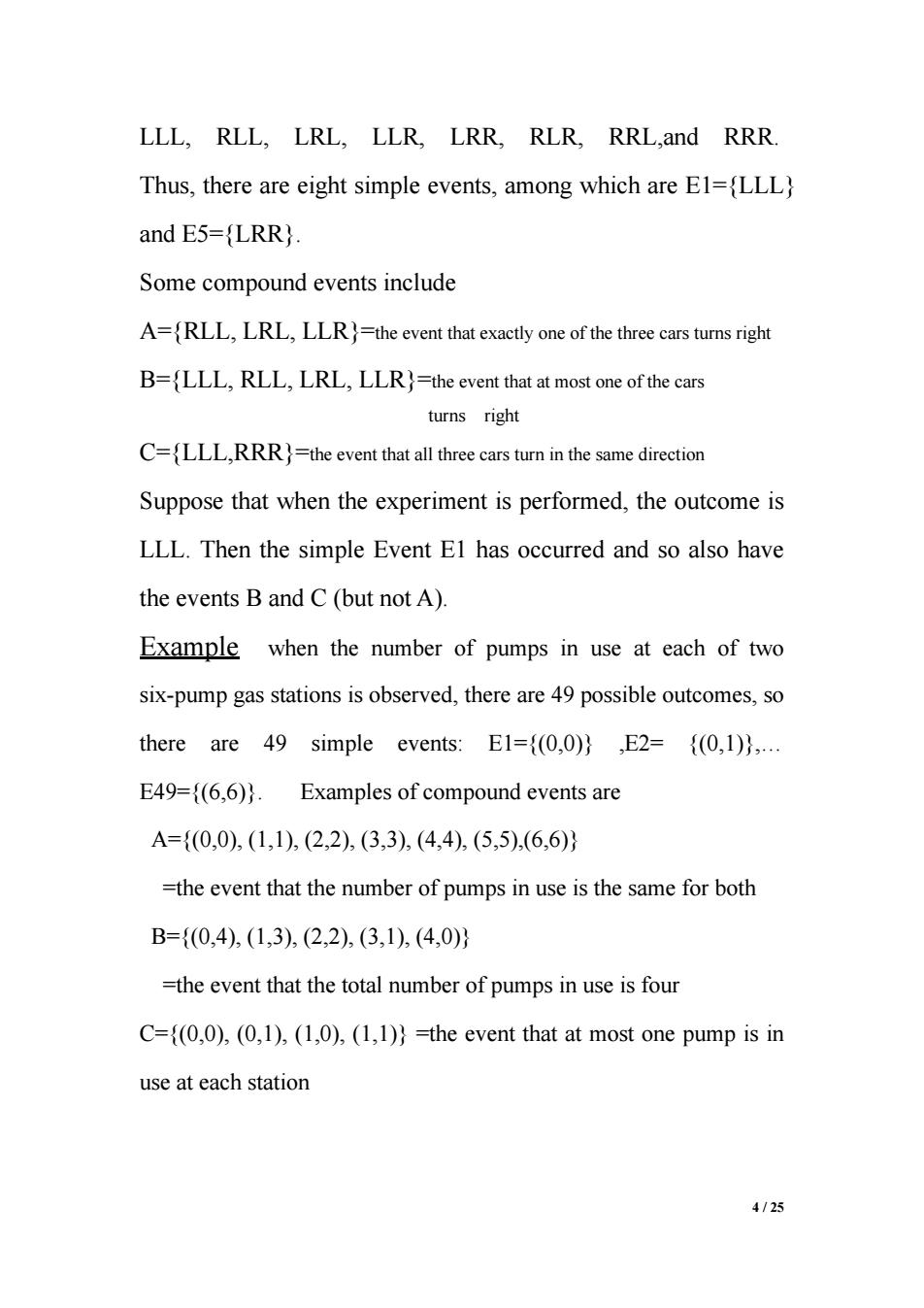
LLL,RLL,LRL,LLR,LRR,RLR,RRL,and RRR Thus,there are eight simple events,among which are El=(LLL} and E5=LRR). Some compound events include A={RLL,LRL,LLR)=the event that exactly one of the three cars turns right B=LLL,RLL,LRL,LLR)=the event that at most one of the cars turns right C=LLL,RRR)=the event that all three cars turn in the same direction Suppose that when the experiment is performed,the outcome is LLL.Then the simple Event EI has occurred and so also have the events B and C (but not A). Example when the number of pumps in use at each of two six-pump gas stations is observed,there are 49 possible outcomes,so there are 49 simple events:E1=(0,0)),E2={(0,1)),... E49=(6,6)).Examples of compound events are A={(0,0),(1,1),(2,2)(3,3),(4,4),(5,5),(6,6)} =the event that the number of pumps in use is the same for both B={(0,4),(1,3),(2,2),(3,1),(4,0)} =the event that the total number of pumps in use is four C=(0,0),(0,1),(1,0),(1,1);=the event that at most one pump is in use at each station 4/25
4 / 25 LLL, RLL, LRL, LLR, LRR, RLR, RRL,and RRR. Thus, there are eight simple events, among which are E1={LLL} and E5={LRR}. Some compound events include A={RLL, LRL, LLR}=the event that exactly one of the three cars turns right B={LLL, RLL, LRL, LLR}=the event that at most one of the cars turns right C={LLL,RRR}=the event that all three cars turn in the same direction Suppose that when the experiment is performed, the outcome is LLL. Then the simple Event E1 has occurred and so also have the events B and C (but not A). Example when the number of pumps in use at each of two six-pump gas stations is observed, there are 49 possible outcomes, so there are 49 simple events: E1={(0,0)} ,E2= {(0,1)},… E49={(6,6)}. Examples of compound events are A={(0,0), (1,1), (2,2), (3,3), (4,4), (5,5),(6,6)} =the event that the number of pumps in use is the same for both B={(0,4), (1,3), (2,2), (3,1), (4,0)} =the event that the total number of pumps in use is four C={(0,0), (0,1), (1,0), (1,1)} =the event that at most one pump is in use at each station
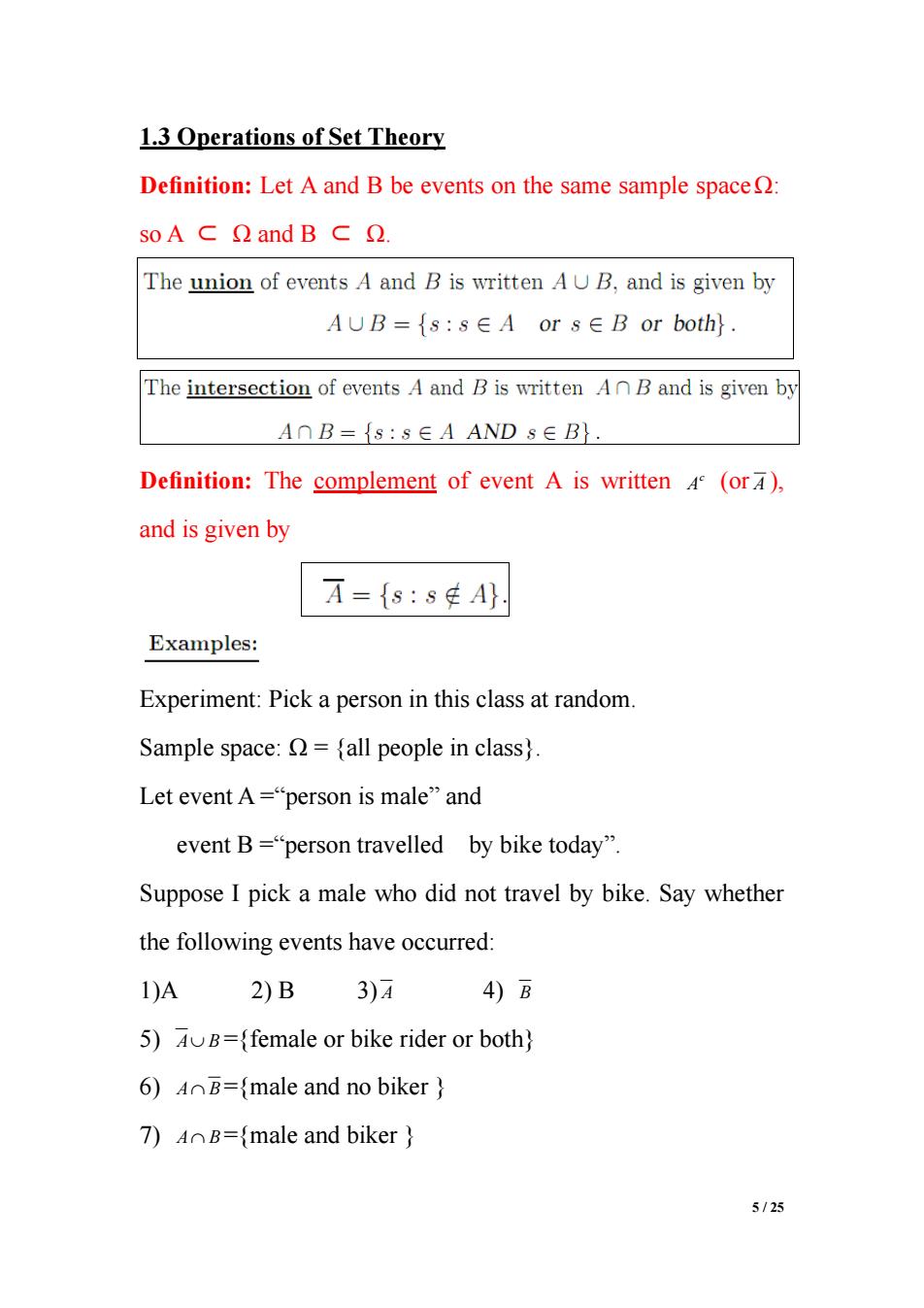
1.3 Operations of Set Theory Definition:Let A and B be events on the same sample space: soAcΩand B CΩ. The union of events A and B is written AUB,and is given by AUB={s:s∈Aors∈B or both} The intersection of events A and B is written AnB and is given by A∩B={s:s∈A AND s∈B}. Definition:The complement of event A is written(or), and is given by 万={s:s年A} Examples: Experiment:Pick a person in this class at random. Sample space:fall people in class) Let event A=“person is male'”and event B=“person travelled by bike today”. Suppose I pick a male who did not travel by bike.Say whether the following events have occurred: 1)A2)B3)A 4)B 5)AB=female or bike rider or both) 6)0B={male and no biker 7)40B=(male and biker} 5125
5 / 25 1.3 Operations of Set Theory Definition: Let A and B be events on the same sample space Ω: so A ⊂ Ω and B ⊂ Ω. Definition: The complement of event A is written c A (or A ), and is given by Experiment: Pick a person in this class at random. Sample space: Ω = {all people in class}. Let event A =“person is male” and event B =“person travelled by bike today”. Suppose I pick a male who did not travel by bike. Say whether the following events have occurred: 1)A 2) B 3) A 4) B 5) A∪ B ={female or bike rider or both} 6) A∩ B ={male and no biker } 7) A∩ B ={male and biker }